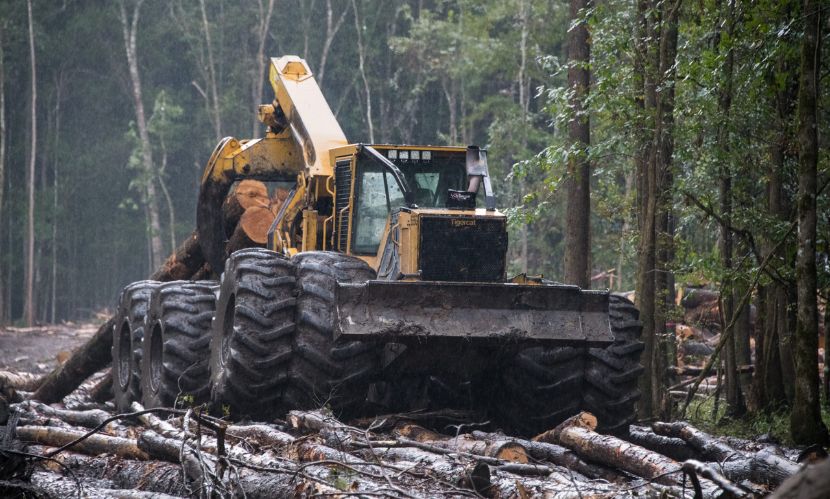Forestry Tire Market Overview
The forestry tire market plays a critical role in supporting the global forestry industry by providing specialized tires that meet the unique demands of forestry machinery. These tires are designed to offer superior performance in rugged terrains, ensuring that forestry equipment can operate efficiently and safely. The market is characterized by the increasing adoption of advanced tire technologies that enhance durability, traction, and fuel efficiency. The growing emphasis on sustainable forestry practices, coupled with the need for efficient logging operations, is driving the demand for high-quality forestry tires, making this market a vital component of the forestry industry.
Forestry Tire Market Size
In 2023, the global forestry tire market reached an estimated size of USD 424.56 million. This market size reflects the widespread adoption of forestry tires across various regions, driven by the expansion of the forestry industry and the increasing mechanization of logging operations. As the demand for sustainable and efficient forestry practices grows, so does the need for reliable and durable tires that can withstand the rigors of forested environments. The market is projected to grow at a compound annual growth rate (CAGR) of 4.8% from 2024 to 2032, with the market size expected to reach approximately USD 638.14 million by the end of the forecast period.
Forestry Tire Market Share
The forestry tire market is dominated by several key players who hold significant market shares due to their extensive product offerings and strong distribution networks. Companies like Continental AG, Bridgestone Corporation, and Michelin Retread Technologies, Inc. are among the leading players in this market. These companies have established themselves as leaders through continuous innovation and a focus on meeting the specific needs of the forestry industry. The market share is also influenced by regional factors, with North America and Europe being the leading markets due to the presence of large forested areas and well-established forestry industries.
Forestry Tire Market Trends
Several trends are shaping the forestry tire market, driving innovation and growth. One of the key trends is the increasing focus on sustainability, leading to the development of eco-friendly tires that reduce environmental impact. Another trend is the advancement in tire technology, with manufacturers introducing tires that offer better traction, fuel efficiency, and longer lifespan. The growing adoption of radial tires in forestry applications, due to their superior performance and durability, is also a notable trend. Additionally, there is a rising demand for tires that can support heavier loads, as modern forestry machinery becomes more powerful and efficient.
Forestry Tire Market Analysis
The forestry tire market is characterized by steady growth, driven by the expanding global forestry industry and the increasing mechanization of logging operations. The demand for forestry tires is closely linked to the health of the forestry sector, which in turn is influenced by factors such as timber prices, deforestation rates, and government policies on sustainable forestry. The market is also influenced by technological advancements, with manufacturers focusing on developing tires that offer enhanced performance, durability, and sustainability. However, the market faces challenges such as fluctuating raw material prices and the impact of environmental regulations, which can affect production costs and profitability.
The market analysis highlights the importance of innovation and sustainability in driving the growth of the forestry tire market. As the forestry industry continues to evolve, the demand for specialized tires that can meet the unique challenges of forested terrains is expected to increase. Manufacturers are likely to focus on developing new products that address the specific needs of the forestry industry, such as tires with improved traction, lower rolling resistance, and greater durability.
Forestry Tire Market Segmentation
The forestry tire market can be segmented based on several factors:
- Tire Type:
- Bias Tires: Known for their durability and resistance to punctures, bias tires are widely used in forestry applications.
- Radial Tires: Offering superior traction and fuel efficiency, radial tires are gaining popularity in the forestry industry.
- Application:
- Harvesters: Tires designed for harvesters need to provide excellent traction and stability in uneven terrains.
- Forwarders: These machines require tires that can support heavy loads and provide smooth operation in challenging conditions.
- Skidders: Skidders need tires that offer high durability and resistance to cuts and punctures.
- Region:
- North America: A leading market due to the presence of vast forested areas and a well-established forestry industry.
- Europe: Another significant market with a strong focus on sustainable forestry practices.
- Asia-Pacific: Growing demand for forestry tires due to the expansion of the forestry industry in countries like China and India.
- End-User:
- OEM (Original Equipment Manufacturer): Tires supplied directly to forestry equipment manufacturers.
- Aftermarket: Replacement tires for forestry machinery, accounting for a significant share of the market.
Get a Free Sample Report with Table of Contents
Forestry Tire Market Growth
The forestry tire market is expected to grow at a CAGR of 4.8% from 2024 to 2032. This growth is driven by several factors, including the increasing mechanization of the forestry industry, the rising demand for sustainable forestry practices, and the ongoing advancements in tire technology. The expansion of the forestry industry in emerging markets, such as Asia-Pacific and Latin America, is also expected to contribute to the growth of the forestry tire market. Additionally, the increasing focus on reducing the environmental impact of forestry operations is driving the demand for eco-friendly tires, further supporting market growth.
Recent Developments and Challenges in the Forestry Tire Market
The forestry tire market has seen several recent developments that are shaping its future trajectory. One significant development is the introduction of advanced tire technologies that enhance the performance and durability of forestry tires. Manufacturers are focusing on developing tires with better traction, fuel efficiency, and longer lifespan to meet the evolving needs of the forestry industry. Additionally, there has been a growing emphasis on sustainability, with companies introducing eco-friendly tires that reduce environmental impact.
However, the forestry tire market also faces several challenges. Fluctuating raw material prices, particularly for rubber and steel, can impact production costs and profitability. The market is also affected by environmental regulations, which can increase the cost of manufacturing and limit the availability of certain raw materials. Additionally, the forestry industry itself is subject to various challenges, such as deforestation and changing government policies, which can impact the demand for forestry tires.
Key Players in the Forestry Tire Market
The forestry tire market is highly competitive, with several key players dominating the market. These companies are focusing on innovation, sustainability, and expanding their product portfolios to maintain their competitive edge.
- Continental AG: A leading global tire manufacturer, Continental AG is known for its high-quality forestry tires that offer superior performance in challenging terrains.
- Bridgestone Corporation: Bridgestone is one of the largest tire manufacturers in the world, offering a wide range of forestry tires designed to meet the specific needs of the forestry industry.
- Nortec Company: Nortec specializes in the production of forestry tires and tracks, with a strong focus on durability and traction.
- Michelin Retread Technologies, Inc.: Michelin is a well-known name in the tire industry, offering a range of retreaded tires that provide cost-effective solutions for the forestry sector.
- Apollo Tyres Ltd.: Apollo Tyres is a leading tire manufacturer with a strong presence in the forestry tire market, offering products that are known for their durability and performance.
- Yokohama TWS Holding AB: Yokohama is another major player in the forestry tire market, offering a range of tires that are designed to withstand the harsh conditions of forested environments.
- Guizhou Tyre Co., Ltd. (GTC Group): GTC Group is a Chinese tire manufacturer that offers a range of forestry tires known for their affordability and reliability.
- Interco Tire Corporation: Interco Tire Corporation specializes in the production of high-performance tires for various off-road applications, including forestry.
- JK Tyre & Industries Ltd.: JK Tyre is a leading Indian tire manufacturer with a growing presence in the global forestry tire market.
- Titan International, Inc.: Titan International is a leading manufacturer of off-the-road tires, including forestry tires, with a strong focus on innovation and quality.
- Others: The market also includes several other players who contribute to the competitive landscape of the forestry tire market, offering a diverse range of products to meet the needs of the forestry industry.




